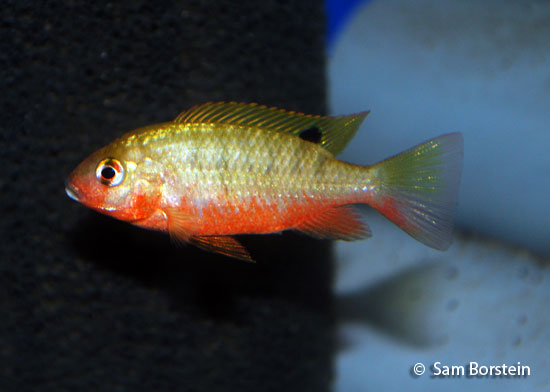'Tilapia' snyderae
Staiassny, 1992



Above: A female Tilapia snyderae. Photo by Sam Borstein.
Etymology:
Genus- Tilapia= fish (Native African).
Intro:
'Tilapia' snyderae is a feisty little Tilapia that brings a lot of attitude to a tank. Although not overly colorful, this fish is fun to watch, and is very active. This fish, first typed in 1992 by Stiassny, is also a member of unique species flock of 'Tilapia' from Lake Bermin, in Cameroon. All these fish are endemic 'Tilapia' and IUCN red listed. Tilapia snyderae is the smallest of all Tilapia.
Tilapia snyderae has 3 color varieties (Stiassny et al., 1992):
- Green
- Pale
- Red
It is questionable whether these are actually different morphs or not. It is thought that they may be behavioral states. Lamboj (2004) has observed all three colorations in the same individuals depending on the mood of the fish. My aquarium observations are the same as Lomboj's and I've found 'Tilapia' snyderae is able to quickly change color depending on the situation.
Recent phylogenetic studies have found Tilapia to be paraphyletic and it is almost certain that generic status of'Tilapia' snyderae will change (Lamboj, 2004). Most likely the subgenus Coptodon, which 'Tilapia' snyderae belongs to, will be raised to a full generic status.
Distribution:
'Tilapia' snyderae is endemic to Lake Bermin, a small 144 acre lake in Cameroon. Because it is in the middle of the jungle, the lake is littered with leaves, fallen branches, and logs. The pH is around 7.5 (Lamboj, 2004).
Size, Maturity, and Sexual Dimorphism:
Size: Males- 2 inches, Females-1.5inches. In aquarium, over fed 'Tilapia' snyderae may get larger than this, up to 4 inches.
Maturity: .75 inches
Sexual Dimorphism: Males are larger and more colorful. Gravid females have a great amount of red in their belly and chest, which is quite noticeable during spawning.
Care:
'Tilapia' snyderae is easy to care for. These fish are very hardy and can be kept in a many types of water. 'Tilapia' snyderae is very aggressive, so keep the fish in a larger tank. Although tiny, they are pugnacious. They can be quite aggressive and dominate larger fish. I don't recommend keeping this fish in pairs, because males will turn on females, but rather in groups of 6-8. This should be done in a tank no smaller than a 40 breeder. You can have a variety of other fish in with these guys. Just make sure they are not to big as they can eat the 'Tilapia' snyderae and that they can handle aggression. They seem to make great dither fish for Central American cichlids.
'Tilapia' snyderae is an effecient hair algae eater, which is a nice quality as not many fish will eat the stuff. I highly recommend them for the eradication of it. I had one male 'Tilapia' snyderae rid a 75 gallon tank full of hair algae in about 5 days
Diet:
'Tilapia' snyderae is omnivorous in the wild, but a large part of the diet is algae. I fed a variety of foods such as fish Dainichi Veggie Deluxe, Tetra Cichlid Sticks, and New Life Spectrum and the fish thrived.
Breeding:
It is not hard to breed this fish. They are almost the Convict Cichlid of West Africa. They are a cave spawner, so provide caves, preferably with small openings. The eggs are guarded well. In about 8 days, they were free swimming. Spawns are usually 20-40 fry, but can be as large as 100.
Fry grow quickly, and after 1 month are about .5 inches long. They fry are small at first and need to be fed brine shrimp. By two months the fish are at least an inch long and capable of spawning.
Conclusion:
This is a Westie that has good color and is unique, even for being a Tilapia. If it wasn't so aggressive, this fish would probably be more popular. If you like small feisty fish, or need a good dither for a mid-size Central American, these fish are great.
References:
- IUCN. IUCN Red List of Threatened Species. <http://www.iucnredlist.org>.
- Lamboj, A. (2004). The Cichlid Fishes of Western Africa. Bergit Schmettkamp Verlag, Bornheim, Germany, 255 pp.
- Stiassny, M. L. J., Schliewen, U. K. & Dominey, W. J. (1992) A new species flock of cichlid fishes from Lake Bermin, Cameroon with a description of eight new species of Tilapia (Labroidei: Cichlidae). Ichthyological Exploration of Freshwaters 3, 311-346.
